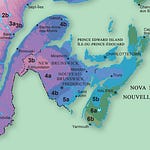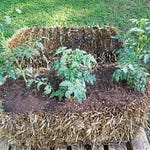I discovered the wonderful world of permaculture gardening in 2010. I was just minding my own business watching YouTube videos one day when I saw a guy with an awesome garden, and he said that he had a “permaculture” garden. I was intrigued, and I did a lot of reading, and I adopted a permaculture approach to gardening the following year. It’s been over a decade since then, and there has been lots of trial and error, but I have stayed with the permaculture approach, and found a way to make it work for me. With that having been said, I can’t help but notice that it seems like every Tom, Dick, and Harry is teaching permaculture courses these days. I find this perplexing, because permaculture is very easy to understand at a very basic level - which is enough for most backyard gardeners - and one only need read a book or two in order to develop a fairly sophisticated understanding of the approach.
What is permaculture?
There are stacks of books written on permaculture, and the definition on Wikipedia is pages long, but for the purposes of this article, the first sentence says enough:
“Permaculture is an approach to land management and settlement design that adopts arrangements observed in flourishing natural ecosystems.”
The idea behind permaculture is simple: look at nature, study and understand how it works, and then try to copy it when using land for agriculture and other human purposes, while observing an over-arching ethic of taking care of the earth.
There is a forest behind my house. It is always teeming with life: from tiny fungi, bacteria and protozoa; to wild berries, black bears, and giant trees. No one ever waters, tills or fertilizes that forest - but despite that apparent neglect, it is always doing fine - because all the right things are growing in all the right places, water is maximally conserved, and nothing ever goes to waste. There are places where there are lots of maples trees, and places where there are no maple trees for miles. There are places that only have waist high bushes, and others that only have alders. Things that grow at the top of hills do not grow at the bottoms of the same hills. This is permaculture - but not by human design. Instead the “design” of the forest has been worked out over eons. What works stays; what doesn’t work fails. Over time, all the right things end up in all the right places.

How does it work in a backyard garden?
Adopting a permaculture approach to gardening is all about copying natural systems, so that gardens thrive despite apparent neglect. For the backyard gardener, this can be as simple as keeping everything mulched, composting all garden waste, and trying different varieties of plants at different locations in the garden to see what works best. When done well, permaculture gardens grow with very little time spent on maintenance because that apparent neglect in maintenance is a result of effort in design. It takes thought, experimentation, and a deep connection with your gardening space to make good decisions and then learn from them. It takes time - but not eons thankfully, because you don’t have that kind of time!
Beware of would-be gurus
The world of permaculture is replete with gurus, but I personally think it’s never a good idea to follow a guru of any kind - full stop. All gurus are human, and it is very rare that a human can stay humble when being treated like a guru. Since it is arguable that humility is integral to the learning process, it’s difficult to see how any guru can maintain the student mind. As a result, over time, the guru stops learning, but keeps teaching despite the intellectual stagnation. Perhaps there are rare individuals that can rise above such human frailty, but I would wager that opposite is the case more often than not.
Now let us enter the world of social media garden gurus offering permaculture courses (the land of Tom, Dick and Harry). How does one become a permaculture teacher offering courses on permaculture?
Say you’re an expert, then create a website offering courses.
Write a book on permaculture, then say you’re an expert, then create a website offering courses.
Take a course from a famous permaculture expert, then say you’re an expert, then create a website offering courses.
Personally, I’m far too skeptical to place any confidence in a certification structure like this. For me, it makes more sense to just read the same books that all these people read, and then go try stuff out in my garden. Also - everything about permaculture is intuitive, in fact, a good deal of permaculture is simply the rediscovery of stuff that ancient people figured out for themselves centuries ago prior to the advent of modern, industrialized agriculture. It’s not rocket science!
Just read stuff and get gardening!
Online videos are great, but they tend to be brief, never go into great detail, and are often edited with the goal of getting views, rather than teaching. A truly good gardening book is a labour of love, written by a person that has devoted a considerable portion of their life to gardening, and is sharing the insights gained through that experience. The work goes into detail, and covers topics that do not always make for good viewing content. Also, because its a book, it has hours and hours of content that would not otherwise be directed at you by an online algorithm. As a result, you end up stumbling upon subjects that you might never have thought to explore otherwise. One good book by any of the well-recognized permaculture authors is probably enough to get a firm understanding of what permaculture is all about. The rest of the learning process is all about learning by doing. A key principle of permaculture is “observe and interact”. There is no course that can offer such an experience. It happens when you are in the garden, making thoughtful observations, and reflecting on them over time, developing a relationship with your gardening space. It is an internal, introspective process of personal growth, but it can also involve a lot of experimentation and playing.
Final Thoughts
The key point of this article is not that permaculture courses are a waste of time. Some people crave the student-teacher relationship. Some people value the social aspect of in-person teaching. Some courses are wonderful, informative, and fun. I have no problem with any of that. My point is simply that you don’t NEED to take a permaculture course to learn about permaculture. There are a handful of books that everyone who is an “expert” has read - so all you need to do is read those books and then put the ideas into practice. For the backyard gardener, the knowledge gained by reading any one of the key books by Bill Mollison, David Holmgren, Ruth Stout, Masanobu Fukuoka, Sepp Holzer, or Edward H. Faulkner might be equivalent to that of any permaculture course out there, and far, far cheaper. This can even be done for free, because there are excellent free books available online, like this one by Bill Mollison, or this one by Bill Mollison, or this one by Sepp Holzer. If you are considering spending real money on a permaculture course, maybe read a free book first.












Share this post